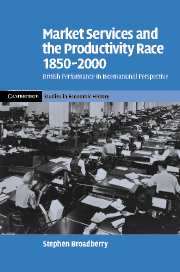 Market Services and the Productivity Race, 1850–2000
Market Services and the Productivity Race, 1850–2000 from Part II - Explaining comparative productivity performance
Published online by Cambridge University Press: 25 July 2009
Introduction
The industrialisation of services was accompanied by investments in physical and human capital, which are documented and analysed in this chapter. Sectoral data on physical capital are available for services to only a very limited extent before World War II, and there are significant problems of international comparability even after World War II. The available data nevertheless suggest a limited contribution of international differences in capital intensity to explaining international differences in labour productivity in services. However, a large part of overall capital in services consists of buildings, with at best an indirect link to labour productivity. It is therefore also useful to focus more narrowly on office machinery, which suggests a more significant role for investment in physical capital.
In human capital formation, it is important to consider both education and vocational training, and to distinguish between higher (university degree equivalent) and intermediate (between school leaving and degree equivalent) levels of vocational training (Prais, 1995: 17). Adding together the different types of human capital formation, Britain suffered little human capital disadvantage relative to either Germany or the United States before World War II, particularly in services. However, after World War II any higher-level advantage that Britain had enjoyed over the United States in services from the large number of qualified members of professional associations was offset by the spread of mass higher education in the United States.
To save this book to your Kindle, first ensure [email protected] is added to your Approved Personal Document E-mail List under your Personal Document Settings on the Manage Your Content and Devices page of your Amazon account. Then enter the ‘name’ part of your Kindle email address below. Find out more about saving to your Kindle.
Note you can select to save to either the @free.kindle.com or @kindle.com variations. ‘@free.kindle.com’ emails are free but can only be saved to your device when it is connected to wi-fi. ‘@kindle.com’ emails can be delivered even when you are not connected to wi-fi, but note that service fees apply.
Find out more about the Kindle Personal Document Service.
To save content items to your account, please confirm that you agree to abide by our usage policies. If this is the first time you use this feature, you will be asked to authorise Cambridge Core to connect with your account. Find out more about saving content to Dropbox.
To save content items to your account, please confirm that you agree to abide by our usage policies. If this is the first time you use this feature, you will be asked to authorise Cambridge Core to connect with your account. Find out more about saving content to Google Drive.